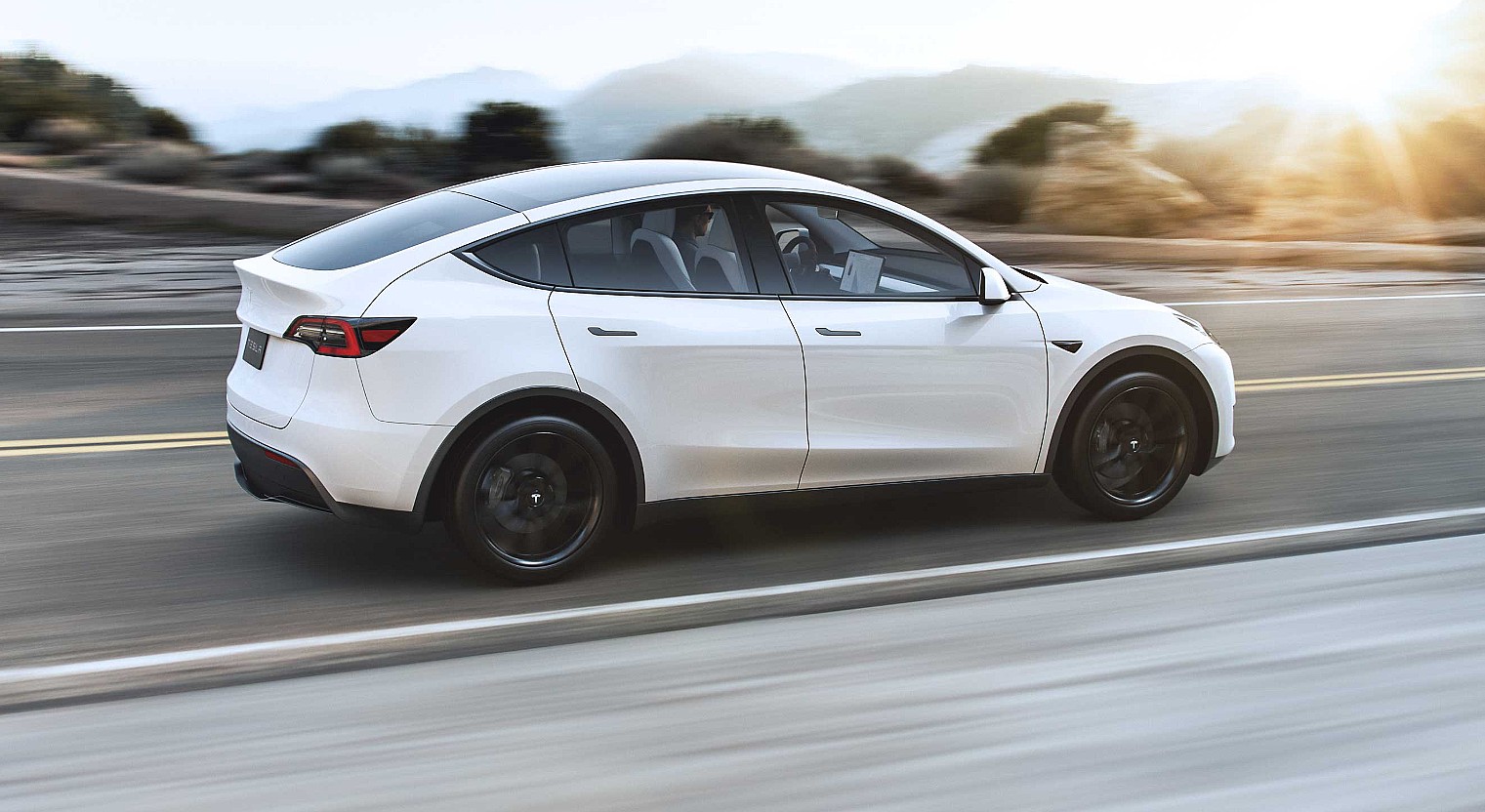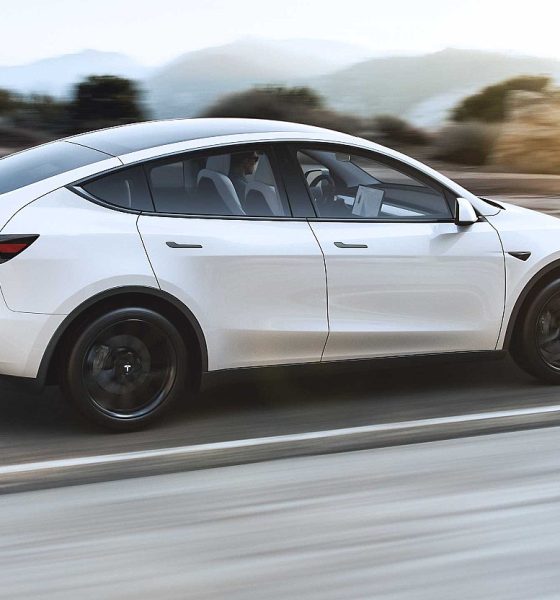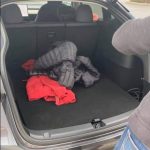

News
Tesla Model Y completes the equation for the average household
Tesla Model Y’s performance and practicality will complete the equation for households in the US, China, and beyond.
In the United States, demand for crossovers has increased over the last two decades. Crossovers only accounted for about 4% of vehicle sales in 2000 and meteorically rose to roughly 40 percent of US sales in 2018. In China, the biggest automotive market in the world, the picture is basically the same as more people veer away from light vehicles and go for crossovers and SUVs. Tesla will answer the need of households for a vehicle that presents a good balance between a sedan and an SUV.
The Model Y makes sense for families looking for a bigger ride (but not as big as full-sized SUVs) that offers more space for people and cargo while not burning a big hole in one’s bank account. The Model Y is perfect for families leading an active lifestyle or for those looking for a second vehicle that complements their daily driver such as a Model 3. The Model Y is not just a chunkier Model 3. The electric crossover answers these needs of the average household and has the potential to become another cash cow for Tesla to help it achieve consistent profitability.
Tesla Model Y’s range and efficiency were highlighted during the Q4 2019 earnings call of the Silicon Valley-based electric carmaker. CEO Elon Musk told the electric vehicle community that the Model Y now boasts the highest energy efficiency rating among electric SUVs at 4.1 miles per kWh and has an EPA rating of 315 miles on a single charge. Tesla has started limited volume production in January and expects to make first deliveries of the electric crossover on March 15.
“…make sure we get that production ramp going and reach volume production as soon as possible with Model Y. Yes, go as fast we can with Model Y and make sure it’s a great product. I think there are some things that will differentiate it. I think… when people do a teardown of the Model Y, I think they will be impressed about some of the things they see,” Musk said during the Q4 2019 earnings call.
While a Model Y teardown is still a long shot, the latest sightings of the much-awaited electric crossover show why the vehicle can be a practical choice for people on the go or families with an active lifestyle.
Tesla Model Y Roof Rack
A Tesla Model Y with roof rack was recently spotted along the State Route 237 in Sunnyvale, California. The sighting gives Model Y fans a glimpse of how roof-mounted rails will look on the electric crossover.
The video posted by RKT on YouTube shows a roof rack that reminds one of the currently available Model 3 roof rack that can easily be installed by securing four mounting points on the all-glass roof of the vehicle. With the Model Y sharing roughly 75% of its DNA with the Model 3, there’s a high possibility that a similar roof rack for the Model Y will be sold by Tesla.
With a roof rack, the Model Y can be a perfect road trip vehicle for a group of five or even seven bringing bikes, skis, other sports gear, or cargo boxes. The average maximum load rating or roof racks is around 150 lbs.
Check out RTK’s video of the Model Y with a roof rack:
Tesla Model Y Towing
Last December, a Tesla Model Y with a clearly visible tow hitch was spotted hinting that the all-electric crossover would be perfect for towing small trailers or campers for families who love the outdoors.
Just last week, another Model Y was seen on the road, this time towing a dirt bike. An image originally captured by Rober Rorschach was shared on Twitter by @Testletter.
Model Y towing a dirt bike. I think the towing package is going to come standard in the Model Y (at least in LR versions)
📷: Robert Rorschach https://t.co/fpFyxoaWlK thanks @AnythingTesla for the tip! pic.twitter.com/r7SfLd78px
— Tesletter (@tesletter) February 21, 2020
This is another great demonstration of how the upcoming electric crossover is ideal for people who lead an active lifestyle. It is not yet confirmed if the Model Y will come standard with a tow hitch or if it will come as an option but it is a clear indication that Tesla’s testing such feature and it knows how the crossover could be used by the electric vehicle community. Model 3 in Europe comes with an option for a tow hitch but this option is not available in North America.
Tesla Model Y Spacious Trunk Storage
It has been highlighted how Tesla seems to haven been underpromising and overdelivering when it comes to Model Y and this strategy can clearly upset the naysayers of the electric carmaker. The Model Y, according to Tesla will have higher gross margins than Model 3 and Elon Musk even predicts that it can outsell its other vehicles in the lineup. And with Model Y sightings slowly revealing the details of how the vehicle can be so useful for people. The 2nd-row seats that can be individually folded are a stroke of design genius in terms of practicality but it can be clearly seen now that Tesla paid attention to the details that matter most to consumers.
New Model Y images that surfaced over the weekend show that the Model Y also offers generous space in its trunk and there could also be additional space under the main trunk. The order page on the Tesla website indicates that the vehicle will have a max cargo volume of 66 cu.ft. making it comparable to the amount of cargo the more affordable Honda CR-V can carry and offers a bit more space than its touted rival Ford Mustang Mach-E that comes with 59.6 cubic feet of room.
Below are the images of the Model Y trunk first posted by Thomas Andre Davik on the Tesla Model Y Enthusiast Facebook Page and the extra storage below the main trunk photo by Josh Jones on the same fan page:
- Tesla Model Y trunk (Source: Thomas Andre Davik | Model Y Enthusiast Facebook Page)
- Tesla Model Y extra storage under main trunk(Source: Josh Jones | Model Y Enthusiast Facebook Page)
The latest images also clearly show that the second-row seats offer generous headroom and that the spacious trunk can easily be reconfigured to give enough space for the third-row seats to allow the vehicle to carry seven adults. And that is another practicality factor that can help the Model Y stand tall against its rivals.

Elon Musk
SpaceX issues statement on Starship V3 Booster 18 anomaly
The incident unfolded during gas-system pressure testing at the company’s Massey facility in Starbase, Texas.

SpaceX has issued an initial statement about Starship Booster 18’s anomaly early Friday. The incident unfolded during gas-system pressure testing at the company’s Massey facility in Starbase, Texas.
SpaceX’s initial comment
As per SpaceX in a post on its official account on social media platform X, Booster 18 was undergoing gas system pressure tests when the anomaly happened. Despite the nature of the incident, the company emphasized that no propellant was loaded, no engines were installed, and personnel were kept at a safe distance from the booster, resulting in zero injuries.
“Booster 18 suffered an anomaly during gas system pressure testing that we were conducting in advance of structural proof testing. No propellant was on the vehicle, and engines were not yet installed. The teams need time to investigate before we are confident of the cause. No one was injured as we maintain a safe distance for personnel during this type of testing. The site remains clear and we are working plans to safely reenter the site,” SpaceX wrote in its post on X.
Incident and aftermath
Livestream footage from LabPadre showed Booster 18’s lower half crumpling around the liquid oxygen tank area at approximately 4:04 a.m. CT. Subsequent images posted by on-site observers revealed extensive deformation across the booster’s lower structure. Needless to say, spaceflight observers have noted that Booster 18 would likely be a complete loss due to its anomaly.
Booster 18 had rolled out only a day earlier and was one of the first vehicles in the Starship V3 program. The V3 series incorporates structural reinforcements and reliability upgrades intended to prepare Starship for rapid-reuse testing and eventual tower-catch operations. Elon Musk has been optimistic about Starship V3, previously noting on X that the spacecraft might be able to complete initial missions to Mars.
Investor's Corner
Tesla analyst maintains $500 PT, says FSD drives better than humans now
The team also met with Tesla leaders for more than an hour to discuss autonomy, chip development, and upcoming deployment plans.

Tesla (NASDAQ:TSLA) received fresh support from Piper Sandler this week after analysts toured the Fremont Factory and tested the company’s latest Full Self-Driving software. The firm reaffirmed its $500 price target, stating that FSD V14 delivered a notably smooth robotaxi demonstration and may already perform at levels comparable to, if not better than, average human drivers.
The team also met with Tesla leaders for more than an hour to discuss autonomy, chip development, and upcoming deployment plans.
Analysts highlight autonomy progress
During more than 75 minutes of focused discussions, analysts reportedly focused on FSD v14’s updates. Piper Sandler’s team pointed to meaningful strides in perception, object handling, and overall ride smoothness during the robotaxi demo.
The visit also included discussions on updates to Tesla’s in-house chip initiatives, its Optimus program, and the growth of the company’s battery storage business. Analysts noted that Tesla continues refining cost structures and capital expenditure expectations, which are key elements in future margin recovery, as noted in a Yahoo Finance report.
Analyst Alexander Potter noted that “we think FSD is a truly impressive product that is (probably) already better at driving than the average American.” This conclusion was strengthened by what he described as a “flawless robotaxi ride to the hotel.”
Street targets diverge on TSLA
While Piper Sandler stands by its $500 target, it is not the highest estimate on the Street. Wedbush, for one, has a $600 per share price target for TSLA stock.
Other institutions have also weighed in on TSLA stock as of late. HSBC reiterated a Reduce rating with a $131 target, citing a gap between earnings fundamentals and the company’s market value. By contrast, TD Cowen maintained a Buy rating and a $509 target, pointing to strong autonomous driving demonstrations in Austin and the pace of software-driven improvements.
Stifel analysts also lifted their price target for Tesla to $508 per share over the company’s ongoing robotaxi and FSD programs.
Elon Musk
SpaceX Starship Version 3 booster crumples in early testing
Photos of the incident’s aftermath suggest that Booster 18 will likely be retired.

SpaceX’s new Starship first-stage booster, Booster 18, suffered major damage early Friday during its first round of testing in Starbase, Texas, just one day after rolling out of the factory.
Based on videos of the incident, the lower section of the rocket booster appeared to crumple during a pressurization test. Photos of the incident’s aftermath suggest that Booster 18 will likely be retired.
Booster test failure
SpaceX began structural and propellant-system verification tests on Booster 18 Thursday night at the Massey’s Test Site, only a few miles from Starbase’s production facilities, as noted in an Ars Technica report. At 4:04 a.m. CT on Friday, a livestream from LabPadre Space captured the booster’s lower half experiencing a sudden destructive event around its liquid oxygen tank section. Post-incident images, shared on X by @StarshipGazer, showed notable deformation in the booster’s lower structure.
Neither SpaceX nor Elon Musk had commented as of Friday morning, but the vehicle’s condition suggests it is likely a complete loss. This is quite unfortunate, as Booster 18 is already part of the Starship V3 program, which includes design fixes and upgrades intended to improve reliability. While SpaceX maintains a rather rapid Starship production line in Starbase, Booster 18 was generally expected to validate the improvements implemented in the V3 program.
Tight deadlines
SpaceX needs Starship boosters and upper stages to begin demonstrating rapid reuse, tower catches, and early operational Starlink missions over the next two years. More critically, NASA’s Artemis program depends on an on-orbit refueling test in the second half of 2026, a requirement for the vehicle’s expected crewed lunar landing around 2028.
While SpaceX is known for diagnosing failures quickly and returning to testing at unmatched speed, losing the newest-generation booster at the very start of its campaign highlights the immense challenge involved in scaling Starship into a reliable, high-cadence launch system. SpaceX, however, is known for getting things done quickly, so it would not be a surprise if the company manages to figure out what happened to Booster 18 in the near future.










